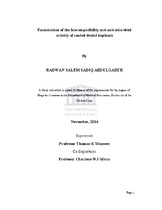| dc.description.abstract | Teeth are important to all people for chewing, speech and aesthetics. Tooth decay,
periodontal disease and physical trauma or injuries are the main causes of tooth
loss. There are different forms of treatment for tooth loss such as dental bridges,
removable dentures and dental implants. Dental implants are considered to be
better than the other options. They have artificial tooth roots that are placed in the
locations of missing teeth. After surgery, osteoblasts attach to the implant and
build new bone around the implant in a process known as osseointegration.
Titanium alloys (especially Ti6Al4V) are the most widely used biomedical
materials in dental and orthopaedic implants due to their excellent
biocompatibility, good mechanical properties and corrosion resistance. Although
Ti6Al4V alloy is a favourable material, dental implants can fail (i.e. loosen and
eventually fall out). Reasons of dental implant failure are microbial infections,
poor surgical execution and biomechanical overloading on the implant surface.
Thus, the aim of this study was to evaluate whether specific novel implant
coatings could improve the biocompatibility and anti-microbial activity of the
standard Ti6Al4V alloy. To that end, the cell adhesion, viability and morphology
of SaOS-2 (osteoblast-like) cells were investigated after culturing them on
samples of Ti6Al4V coated with hydroxyapatite, magnesium oxide and either
titanium dioxide or silicon carbide. Morphology of cells was visualized using
phalloidin-TRITC (for actin fibres) and DAPI (for the nuclei), whereas viability
was determined using propidium iodide (dead cells) and calcein-AM (live cells)
and all were viewed using fluorescence microscopy. The disc diffusion (Kirby-
Bauer) assay was used to determine potential antimicrobial activities of the novel
implant coatings against Candida albicans, Streptococcus sanguinis,
Staphylococcus aureus and Escherichia coli. | |

